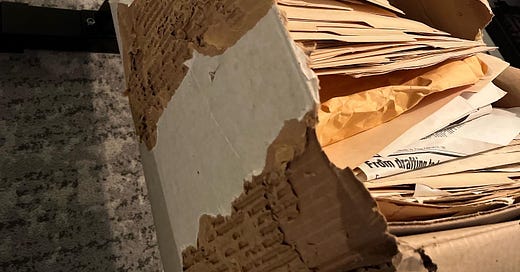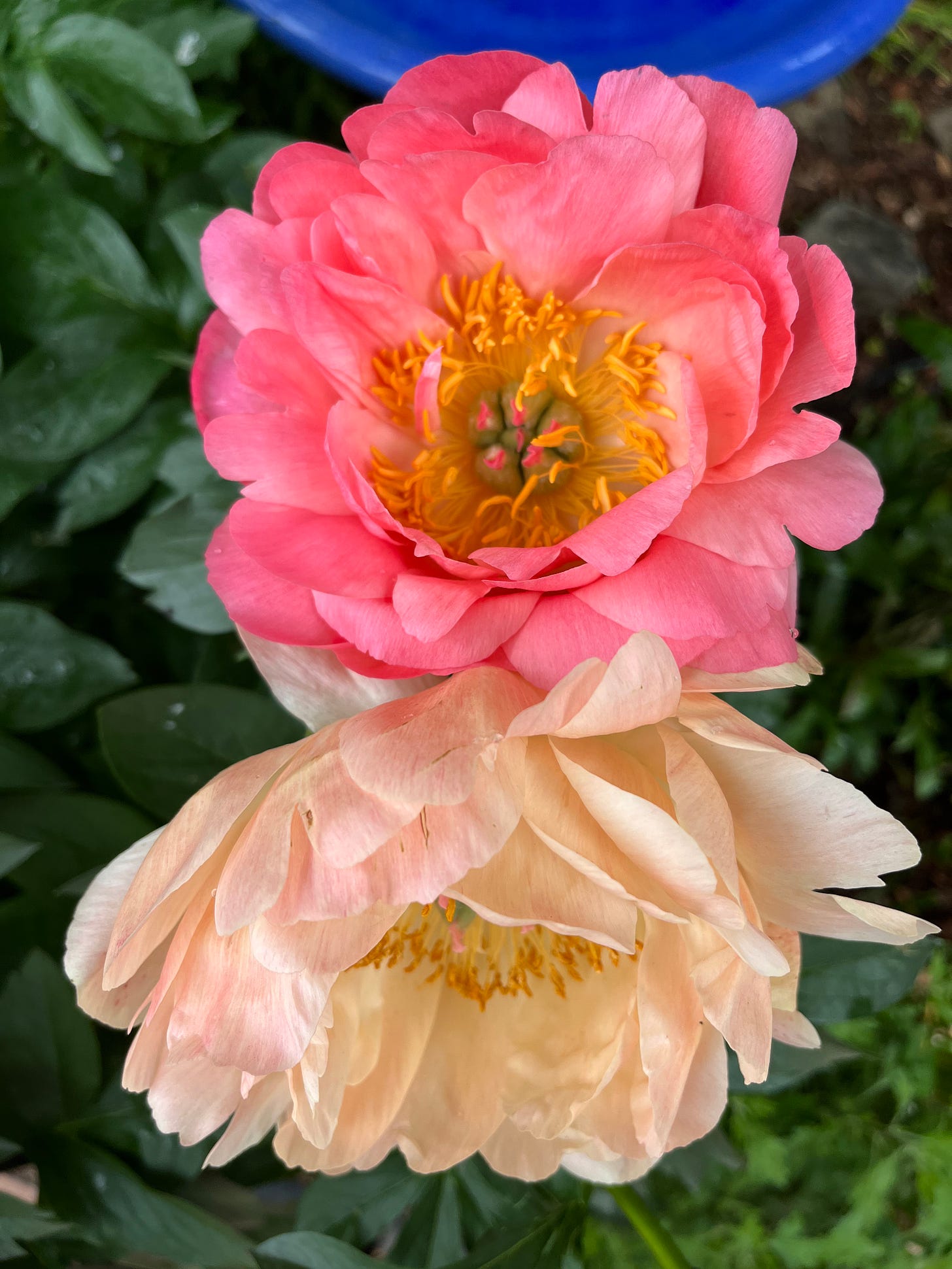I am an archivist’s nightmare. Look at the condition in which I had been keeping decades’ worth of letters—first in a storage unit with zero climate control, then on the floor in a basement. Don’t ask me what tore up the sides of the storage box—squirrels nesting in the storage unit, probably, thought it could have been zombies with a hunger for raw primary sources.
I had a free afternoon earlier this week (so lovely, so rare!). Did I go outside and enjoy the glories of a cool spring day in DC, with the sun high in a bright sky and the neighborhood peonies flaming into life? No! I headed to the basement and dove in.
What a lark! What a plunge! I had Mrs. Dalloway in my mind while I looked through folders of letters from old flames, minor crushes, what-if friends, friends-turned-flings-turned-friends-again, fair-weather friends, friends-til-the-end friends. (Type the word friends often enough and it begins to look and sound like a word in an unknown language.)
Most of the letters dated back to my teens and twenties, the uncertain and angsty college and grad-school and early-career years, back when my friends and I felt everything so keenly that we had to write long and frequent letters about it. Everybody wrote letters—not because we were young and introspective and literary but because we had few other satisfying ways to stay in contact as we fanned out across the landscapes of young adulthood. No smartphones, no group texts, no Insta stories, no Twitter DMs. Email came along eventually, but it never felt like the best medium for personal expression. It still doesn’t.
What will the youngsters of today have to spend beautiful spring afternoons sorting through when they reach my advanced age? (Probably not falling-apart boxes of correspondence, though writing letters has made something of a comeback.) Will the Zsters wish they had more tangible records of how they felt and what they did? Do they have saving systems in place that work for them? Will the kiddos let Big Tech decide what lasts and what doesn’t? Right now they’re too busy surviving a pandemic and the climate crisis and the assault on LGBTQ+ and reproductive rights to worry about what their middle-aged selves will want to spend an afternoon sorting through a few decades down the road. Fair enough.
As far as my own archival systems go, my oldster love of archive boxes and manila folders refuses to die, but my Dropbox folders see a lot more action nowadays. That digital shift presents a different sort of archival challenge, one I’m not fretting about today, though I’ll have to deal with it sooner or later.
As someone with a professional interest in archives and history, I cherish and honor primary sources—unless they’re my own. I could spare an afternoon for my old letters, but I didn’t have the time to reread everything. I didn’t want to. Dirty little secret: A lot of old letters are pretty dull, and some of the most interesting ones you can reread once and consign to the dustbin of personal history. Exhibit A: The fiery letter from my college boyfriend declaring, after our last and final breakup, that our relationship had become utterly bankrupt and that he never wanted to hear from me or hear of me ever again. To be fair, I did give him cause to feel aggrieved. Moving on!
There’s nothing like a few decades of distance to make clear the limits and warping pressures of past relationships. I wasn’t ruthless with my old letters, but I tossed more than I saved. I am not sure why I saved so many to begin with, as though I had sworn an oath to be the caretaker of other people’s histories. Never mistake someone else’s hopes and dreams and foibles as your responsibility to preserve.
At the end of the cull, here’s how much I kept—the visible portion, anyway. Some of the most important bits I tucked away in the mental archive, which I hereby declare off-limits to researchers in perpetuity.
Next up on the sorting front this summer: my writing files and clips. One archive box at a time, friends, one box at a time.
Author life: I had fun chatting with readers (including at least one reader of this newsletter) and selling some books at the Literary Hill BookFest last weekend. More in-person events, please!
Big Belt sale: Do check out Belt’s big spring sale—you get 40% off all Belt books, including mine, with the code SPRINGSALE. So many great books waiting to wing their way to your bookshelves. Don’t miss out.
What I’ve been reading and watching this month:
Meet Me by the Fountain: An Inside History of the Mall by Alexandra Lange, forthcoming from Bloomsbury Books in June. I was lucky enough to get my hands on an ARC, so I get to read it early. I had no idea that malls had such a complex and intentional history, and architecture/design critic Lange is the perfect person to tell that story. Mall haters and fans alike have something to learn from this book.
Fallen Idols: Twelve Statues That Made History by Alex von Tunzelmann. Fascinating case studies of the (literal) rise and fall of icons of (not so) Great Men over the last several centuries, this is a timely read. I listened to the audiobook but wished I’d been able to make notes in the margin. Fallen Idols has been shortlisted for the 2022 Wolfson History Prize, which is how I heard about it.
Tokyo Vice—naive but dogged American reporter gets in over his head as he chases a story that leads him into a dangerous underground world of yakuza violence and police corruption. Highly atmospheric, satisfyingly hardboiled.
Season 2 of “Picard”—I’ve seen lots of complaints about the writing on the show this season, some of them justified, but it’s still Sir Pat Stew and a lot of other very talented actors saving the galaxy and each other, so I’m still in.
Last but not least, please enjoy this photo of some of the aforementioned neighborhood peonies. They are even more glorious in person.
Happy spring, and thanks for reading!
Cheers,
Jen






Thank you, Jennifer! Now can you please help me with my storage unit and my genealogical collection? :^)